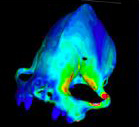Research
The broad goal of research in our lab is to understand associations between the form and function of mammalian skulls and to identify mechanisms underlying the evolution of their diversity. To address these issues, we integrate data summarizing morphology, behavior, performance, and ecology. These elements are integrally linked in the daily lives of mammals and, over evolutionary time, natural selection and the interactions among them have given rise to diversity of mammals we see today. While our work focuses on mammals, we work with collaborators on similar questions in other vertebrate groups including frogs, lizards, and birds.
We feel strongly that a combination of laboratory and field studies is critical to successfully answering the questions we pose. We study the structural variation and mechanical functions of bones in the lab using techniques ranging from simple morphometrics to 3D finite element modeling (see biomesh.org). We also maintain an active field-based research program focused on documenting feeding behavior and performance within and among closely related species.

Morphology provides the set of tools that organisms use to interact with their physical environment. Most simply, morphology defines the structural basis for the ability to perform critical tasks such as procuring food and avoiding predators. With respect to feeding, subtle differences in the morphology of the skull and teeth of mammals often signify adaptations to very different diets.
We feel that in order to fully understand the importance of morphology, it is essential to understand the ways in which animals use morphology, via behavior, as they perform tasks that impact their fitness. With respect to feeding we ask: to what extent can mammals modify feeding behavior for different tasks?, and is there a link between morphology and behavioral plasticity? To answer these questions, we document variation in feeding behavior within and among species in the field.

Informative measures of an organism's performance provide an assessment of its ability to execute tasks that are associated, directly or indirectly, with fitness. In our work on feeding in mammals, we use bite force as a performance variable because it defines the range of food resources that animals can bite into and break apart with their teeth.
Captive meerkat biting on a bite force meter

